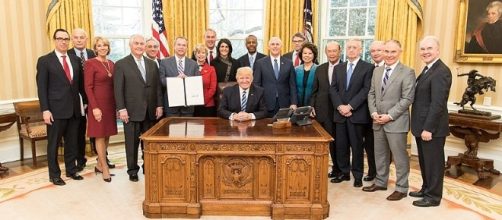An analysis of the Annual Report to Congress from the Executive Office of the President released Friday found that women in the White House under President Donald Trump earn about 20 percent less than men.
This gap, according to CNN, exists largely because women in Trump’s administration have filled lower-ranking jobs. Half of the men working for the White House earn $95,000 or more each year, while half of the women earn $70,100 or less.
A few exceptions
However, several women under Trump are paid as much as men in the White House. Exceptions include senior counselor to the president, Kellyanne Conway; Director of Communications Omarosa Manigault; and Deputy National Security Advisor Kathleen McFarland.
Several White House staffers who receive no salary were omitted from the report, including the president’s daughter Ivanka Trump, her husband Jared Kushner and a former Baltimore real estate developer.
In August of his 2016 presidential campaign, Trump said that women deserve equal pay for equal work, but then dismissed the idea of a gender gap just months later, according to TIME.
Gender pay gap in U.S. history
The Gender Pay Gap existed among previous administrations as well. Although President Barack Obama was a proponent for equal pay, women in his administration earned about 13% less than men as of 2014, TIME reported. By the end of President George W. Bush’s second term in office, the top 25 percent of earners in the White House consisted of 73 percent men and 27 percent women.
Although women have mostly been paid less than men for centuries, the gap has narrowed significantly within the last 50 years, Bloomberg reported. Historically, women were largely confined to domestic life and, when they managed to make their way into the workforce, were met with gender discrimination regarding pay. In 1869, the U.S.
Treasury employed 500 female clerks, paying them only half of what the Treasury paid men.
Discrimination continued during times of war when women filled roles typically held by men while the men were away at war. The U.S. Employment Service published a list in 1918 of acceptable “women’s work” during wartime, including positions like electric machine operator and automobile worker.
Despite this, women across the United States have persisted in fighting for equal rights throughout the 20th and 21st centuries. Women have achieved victories like voting rights in 1920, the legalization of birth control in 1936, and the passage of Title IX in 1964, which has increased work, educational and athletic opportunities for women, and has prohibited sexual harassment.
Republican Sandra Day O’Connor became the first female justice of the Supreme Court in 1981 under President Ronald Reagan, and former Secretary of State and Democrat Hillary Clinton became the first woman to run for president as the candidate of a major U.S. political party in 2016.


